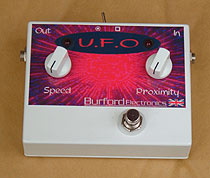 |
 |
 |
|||||||||||||
Updated 2023 loads more vintage parts added |
|||||||||||||||
|
|||||||||||||||
Burford pedals from 2005 & discontinued in 2019, all designed and made by Alan Exley, you can email any enquiries to enquiries@projectguitarparts.co.uk
Any new pedals will be displayed on the Alan Exley Electronics & Pedals page. Many thanks, Alan
For sound samples from some of the Burford range of pedals please click here!
WHITE NOISE GENERATOR II This is a sound generator, ideal for noise cancellation,
sound tracks, like Sci-Fi or relaxation. |
|
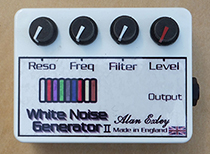 |
MosquitoA New Effects pedal From Burford ElectronicsThe Mosquito Octave Up Fuzz A unique Octave up fuzz, which will give you pure fuzz on one twist of a knob & octave fuzz on one twist of another knob. So you can have your fuzz setting for rich body & add octave fuzz to it or turn the fuzz down & just use the octave fuzz control for cutting lead. There is also a control called Sting, this is a tone filter that alters the voice of the octave from sharp to mellow. The octave is not over the top, on the lower register it is quite subtle, you can even play power chords and it holds together extremely well. Without that horrible modulation that is associated with some analogue octave up pedals even some of the legendary expensive ones. Try soloing somewhere from the 8th fret upwards, it is very responsive and particularly so around 12th/15th fret and even higher. Neck and back pick ups give different sounds. Even playing positions will give different responses. Mosquito features�
|
|
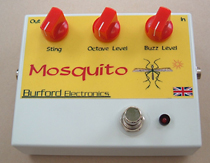 |
Britt BoostThis is the culmination of all the booster pedals from
the 1960's and is fitted with new old stock premium
selected Mullard germanium P.N.P. transistors. Its
features are:
Click here for review |
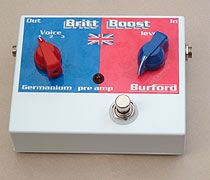 |
|
The Britt Face
|
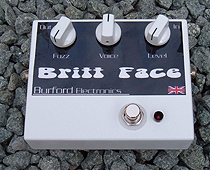 |
|
The Burford Sonic Ranger -Treble BoosterHand-built in the heart of England by Alan Exley for Burford Electronics.A germanium transistor treble boost - This is a clone of the 1960's Rangemaster, one of the most influential pedals ever produced. This is renowned to be the sweetest treble boost ever made and was used for two reasons - one, to give extra cutting edge for rhythm playing and second, to drive the front end of tube amplifiers. The people who used these type of boosters, such as, Hornby Skewes, Orange, The Dallas Rangemaster, Eric Clapton, Brian May, Ritchie Blackmore, Rory Gallagher, Dave Gilmore, and many other English guitarists to push their tube amplifiers into creamy distortion with overtones. The result of the rangemaster into a good tube amplifier is evident on the Bluesbreakers 'beano' recording [into a JTM45]and the first 2 Black Sabbath albums [into a Laney stack] Its features are:
Please note there may be some slight noise on the set or level control, when adjusting between 6 and 10, this is not a fault with the pot or circuit, this is the way the output level is controlled where DC voltage meets AC voltage, this noise is only present when the control is turned and is not present when the control is stationary. Cheers, Alan Click here for review |
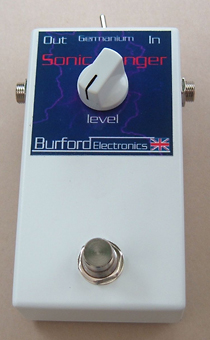 |
|
Rangemaestro treble boosterEffects pedal, Clone of the Dallas Arbiter RangemasterControls on front are, Input, set [level] &
bypass/boost |
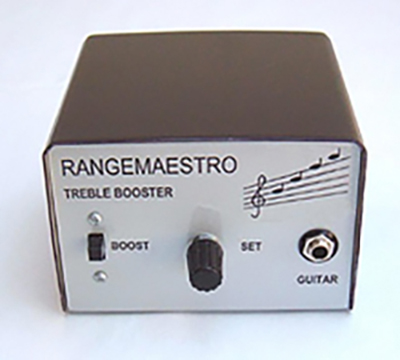 |
|
Burford Electronics Volume Calibrator UnitWire this up to your volume control & you will get a perfect linear sweep in volume & in tonality. Perfect for live or studio use. Comes with easy fit instructions [some soldering skills required] |
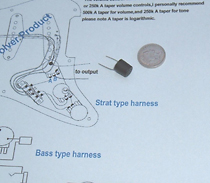 |
|
Burford Electronics Mid Frequency ChokeThe Burford mid frequency choke will remove a lot of the
mid range, giving great rhythm properties and almost
acoustic sounds. When wired in. it will be interactive
with your tone control & gives great Jazz sounds as
well. Totally passive, no batteries, easy fit [some soldering skills required]. |
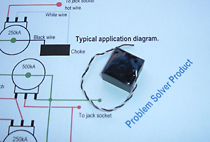 |
|
Robot Ring ModulatorBoutique effects pedal from Burford Electronics
Click here for review |
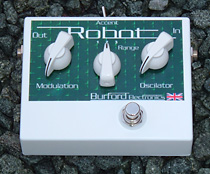 |
|
U.F.O. Repeater TremoloThis is a new pedal from BURFORD ELECTRONICS,
|
|
|
The Reefer Coral Sitar SoundBoutique effects pedal from Burford Electronics
This is one thing missing from the psychedelic era of the sixties. Click here for review |
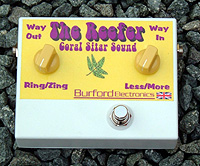 |
|
Techno lo � fiNew effects pedal from Burford Electronics
Controls left to right are - voice, regurge & level Voice is a powerful active filter, which gives you, from normal �crunch tone� through mid range �honk� sounds to wah voicing and through �thick creamy� fuzz tones. Regurge is a powerful voltage controlled filter that gives you straight signal through to synthetic sounds to weird envelope gurgling and is interactive with the voice control. Last one speaks for itself really, less or more between bypass and effect.
Click here for review |
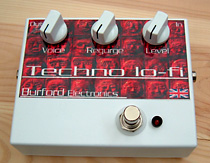 |
|
Burford Solo Master PedalThis is a new pedal designed by Alan Exley, exclusively for Burford Electronics & hand built in EnglandNo more stopping and fumbling around to set your solo
levels on your guitar volume controls or using old
graphics and E.Q. pedals to boost your volume! This
completely transparent FX pedal will give you the true
voice of your guitar and amplifier. Click here for "Total Guitar" review |
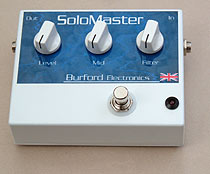 |
 ALL ENQUIRIES EMAIL: enquiries@projectguitarparts.co.uk
ALL ENQUIRIES EMAIL: enquiries@projectguitarparts.co.uk
or telephone Alan on 07762 474964 between 10 am and 3 pm Monday to Friday
 |
 |
 |
 |
 |
 |
 |
 |
 |

|
 |
 |
 |
Site content © Alan Exley/Project Guitar Parts 2007-2025

